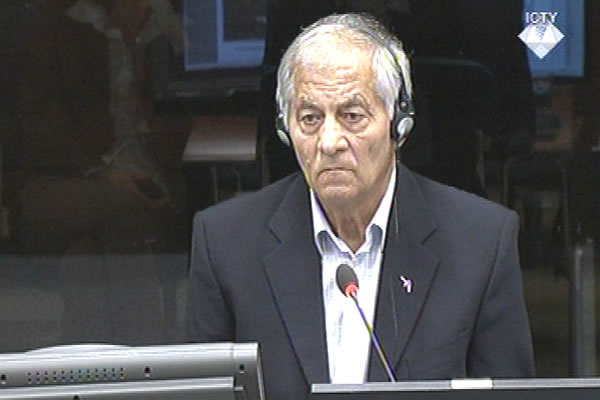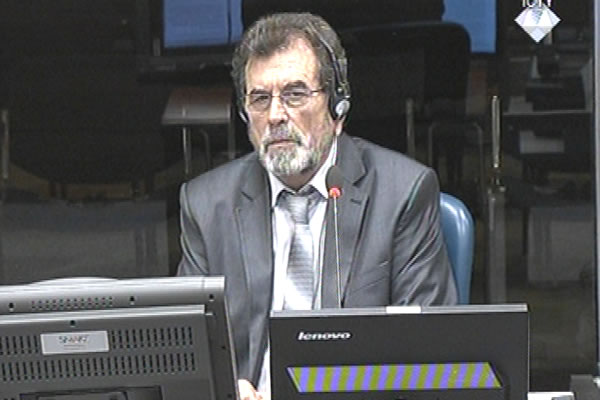Home
‘THE LESS I KNOW, THE BETTER I AM’
Ostoja Marjanovic, former director of the Ljubija Mine, didn’t object when during the war in BH his subordinates failed to keep him informed about the fact that the machinery owned by the mine were used to bury hundreds of bodies in the mining complex. ‘The less I know, the better I am’, the witness concluded at the end of his testimony in Mladic’s defense. Savo Strbac, president of the Veritas NGO, began his testimony after Marjanovic completed his
 Ostoja Marjanovic, defence witness at Rako Mladic trial
Ostoja Marjanovic, defence witness at Rako Mladic trial At the end of Ostoja Marjanovic’s cross-examination the prosecutor focused on the mass graves discovered in the Ljubija mining complex. During the war in BH Marjanovic was the general manager of the mine. The prosecutor put it to the witness that the troops under the command of the accused Ratko Mladic had taken part in burying the non-Serb civilian victims from Prijedor, and that the witness had known that. Marjanovic claimed he didn’t know anything about it.
The prosecutor noted that hundreds of bodies were recovered after the war from the pits that were part of the Ljubija mine: Tomasica, Jakarina Kosa and Redak. Also, the prosecutor presented a photo showing holes that had been excavated at the Jakarina Kosa mass grave using mining machinery. The witness admitted that the Ljubija mining complex did have this type of machinery. Remnants of military equipment and military explosives were found by the bodies in the graves. Marjanovic insisted that he ‘can neither confirm nor deny’ that the army participated in the burial of the bodies and the subsequent efforts to cover up the crime. ‘Do you mean to say that as the general manager of the mine you managed not to learn that’, prosecutor Traldi asked. ‘Yes’, the witness replied promptly.
The witness also said he didn’t know that the remains of hundreds of victims were discovered this year in Jakarina Kosa, a pit in the central part of the Ljubija mine. This was a secondary mass grave, where the bodies moved from Tomasica were reburied. ‘I didn’t follow those developments, believe me. I know only about the funerals at the graveyard near the place where I live’, the witness explained. Speaking about how he as the general manager of the Ljubija mine could remain ignorant of the fact that bodies were buried at Jakarina Kosa during the war, Marjanovic said that Dragoljub Kitonjic, the director of the central mine, was in charge of the Jakarina Kosa pit, and Kitonjic never told him anything. When Judge Flugge asked the witness if he was happy with such behavior, Marjanovic said that he was. ‘The less you know, the better you are’, the witness said.
As the hearing continued, the defense called Savo Strbac, former secretary in the Krajina Serb government and the president of the Commission for the Exchange of Prisoners. Strbac is now the chairman of Veritas, an organization which is trying to keep track of the Serb victims of the war in Croatia. In the examination-in- chief Strbac spoke in detail about the causes of the war. Strbac blamed Croatia for violence against Serbs and provoking the conflict with the JNA.
As Strbac recounted, he met Ratko Mladic, who was the commander of the JNA Knin Corps at the time, in October 1991. The witness explained that Mladic helped him set up an exchange of prisoners from Gospic, and proved to be ‘a tactful and wise’ officer. As the hearing drew to a close, the prosecutor began cross-examining Strbac. The cross-examination will continue and be completed tomorrow.
Photos
Linked Reports
- Case : Mladic
- 2015-11-09 ARMY'S ROLE IN OMARSKA AND TOMASICA
- 2015-11-05 EXPERT COMPLETES EVIDENCE ON SARAJEVO SNIPERS
- 2015-11-04 MLADIC’S EXPERT’S ‘TECHNICAL ERRORS’
- 2015-11-11 KRAJINA WAS MLADIC’S TESTING GROUND FOR BOSNIA
- 2015-11-12 OBSTRUCTING ‘NON-EXISTENT’ TRIBUNAL IN THE HAGUE
- 2015-11-16 ‘TYPICAL CIVIL WAR’ IN BH

